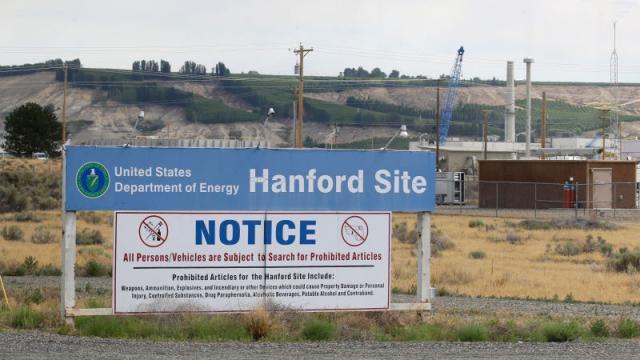Last week, a leak in a storage tank at the America’s largest radioactive dumpsite expanded substantially, sparking concerns that other tanks are on the verge of failing, too. This fear may have already been realised. Rumours are flying that a second of Hanford’s 28 double-shelled radioactive waste tanks is exhibiting early signs of failure.
King-5 News, which broke the story of the expanded waste leak at Hanford site’s AY-102 storage tank, is now reporting evidence of a second tank breach, citing anonymous sources familiar with the situation. The tank in question, AY-101, is the same age and has the same design as AY-102, which began leaking in 2011. Both tanks, along with ten others at the Hanford facility, share a construction flaw identified by the Department of Energy several years back as a potential risk factor for failure.
Hanford is a legacy site that produced plutonium for the world’s first nuclear bomb, and for almost 60,000 more nukes during the Cold War. Its last nuclear reactor was switched off in 1987, and a year later, it was taken over by the US DOE, the Washington State Department of Ecology and the EPA for long-term environmental remediation. Due to the site’s ageing infrastructure and lack of modern environmental monitoring equipment, that remediation process has been slow, dangerous and fraught with failure.
Today, 200.6 million litres of toxic sludge from the dawn of the nuclear age still sit in decrepit tanks at Hanford, waiting for the US government to build a remediation plant. In the early 2000s, evidence of widespread leaking prompted the DOE to transfer the bulk of the waste from 148 single shell tanks built in the ’40s and ’50s to 28 larger, double-shelled tanks built in the 1970s.
The hope was that the double-shelled tanks would prove more robust, but in 2011, AY-102 sprung a leak. Last week, as the final drops of radioactive waste were being transferred out of the busted tank into others, facility workers noticed that the leak had expanded substantially. The result: an accumulation of 20cm of radioactive waste between the inner and outer hull. Both the Washington State Department of Ecology and the DOE told Gizmodo that this was an anticipated result of draining the tank.
But now, King-5 News reports that another double-shelled tank has recently exhibited some dangerous signs:
Sources tell KING 5 that alarms went off last week to alert staff of the presence of “hot” (radioactive) particles trapped in filters of the tank’s continuous air monitor (CAM).
The sources say this is the first time readings of this sort have been detected in AY-101, leading people very familiar with the tank to believe the tank is beginning to fail.
The environmental watchdog group Hanford Challenge issued a press release today claiming that is own sources within the facility have confirmed elevated radiation levels outside of AY-101’s inner shell, which shouldn’t occur if the tank is airtight.
“According to people who work there, this is a very good indicator of failure,” Tom Carpenter, the executive director of Hanford Challenge and former director of the Nuclear Oversight Campaign for the Government Accountability Office told Gizmodo. “Now, it may be a small leak, but it doesn’t matter. If the tank fails, they have to immediately pull together a plan to empty that tank.”
And that would be a big problem for Hanford, which doesn’t have enough room in its 26 remaining tanks to accommodate the extra waste. The facility would need to install new tanks, a process that could take several years. Alternatively, it would need to vastly accelerate plans for a long-term remediation facility, currently scheduled to come online in 2036.
DOE tank manager Tom Fletcher told the AP that visual inspections of the tank have found no evidence of a leak, but that air samples showed elevated levels of radioactivity between the tank’s inner and outer hull. DOE officials are currently looking into the matter.
Image: AP
